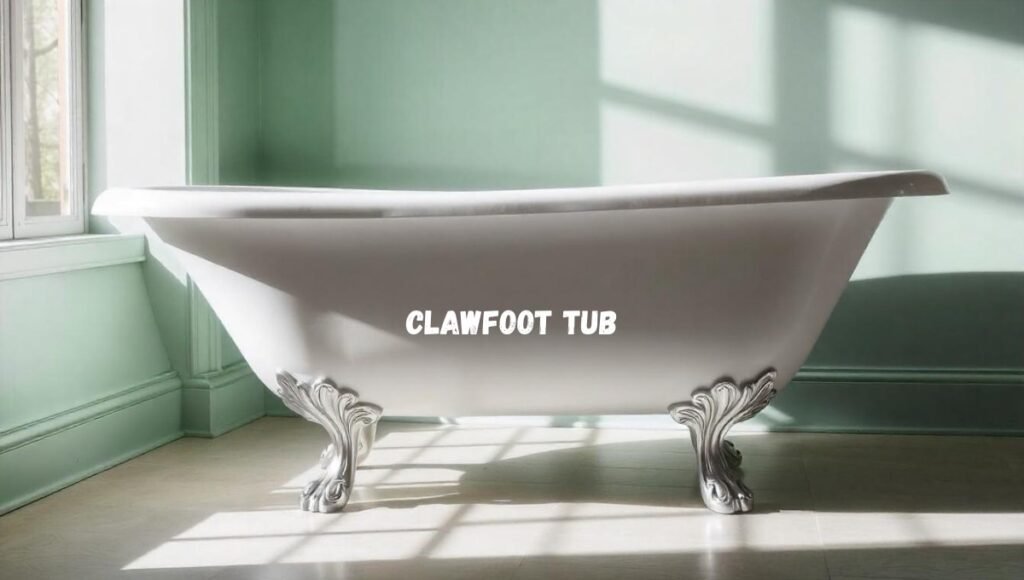Clawfoot tubs are an iconic symbol of luxury and vintage charm, offering a touch of elegance to any bathroom. These freestanding bathtubs are often associated with historical homes and upscale designs, but their popularity continues to soar in modern homes due to their aesthetic appeal and comfort. In this article, we’ll explore the benefits of clawfoot tubs, different types available, their pros and cons, and answer common questions about these stunning fixtures.
What is a Clawfoot Tub?
A clawfoot tub is a freestanding bathtub that stands on four ornamental feet, resembling claws. Traditionally made from cast iron and porcelain, modern versions are also available in materials like acrylic and fiberglass. The vintage aesthetic of clawfoot tubs makes them a popular choice for homeowners looking to combine timeless design with functionality.
Types of Clawfoot Tubs
Clawfoot tubs come in various styles, each catering to different preferences and design needs. The four primary types are:
- Classic Roll-Rim Tub: This is the most traditional style, featuring a uniform height around the tub’s edge and a gently curved rim for added comfort.
- Slipper Tub: One end of the tub is raised higher than the other, allowing bathers to recline more comfortably.
- Double-Slipper Tub: Both ends of the tub are raised, making it perfect for two people to bathe simultaneously.
- Double-Ended Tub: With a symmetrical design, both ends of the tub are rounded, allowing the bather to recline at either end.
Each style offers a unique bathing experience, allowing homeowners to choose a tub that complements their bathroom’s design and personal preferences.
Benefits of Clawfoot Tubs
There are numerous advantages to incorporating a clawfoot tub into your bathroom design:
- Aesthetic Appeal: The vintage and timeless look of clawfoot tubs makes them a focal point in any bathroom, elevating the space’s overall design.
- Comfort: The deep soaking experience offered by clawfoot tubs is unparalleled, allowing for long, relaxing baths.
- Freestanding Design: Since they don’t need to be attached to walls, clawfoot tubs provide flexibility in bathroom layout and design.
- Variety of Styles: With several types and materials to choose from, homeowners can easily find a clawfoot tub that fits both their aesthetic preferences and practical needs.
Clawfoot Tub vs. Built-In Tub
When deciding between a clawfoot tub and a built-in tub, it’s important to consider your space and design preferences. Clawfoot tubs are freestanding, making them more flexible in terms of placement. However, built-in tubs are often more practical for smaller spaces since they are integrated into the room’s layout. Clawfoot tubs offer more aesthetic value and provide a luxurious feel, while built-in tubs are generally easier to clean and more accessible.
Pros and Cons of Clawfoot Tubs
Pros:
- Timeless Design: Clawfoot tubs are classic and never go out of style.
- Deep Soaking: Their deep design provides a luxurious bathing experience.
- Versatility: These tubs can be placed anywhere in the bathroom, offering more design options.
Cons:
- Heavy: Traditional cast iron tubs are extremely heavy and may require floor reinforcement.
- Cost: Clawfoot tubs tend to be more expensive than standard built-in tubs.
- Water Use: Due to their large size, clawfoot tubs require more water to fill.
How to Choose the Right Clawfoot Tub for Your Bathroom
When choosing a clawfoot tub, consider the following factors:
- Size: Measure your bathroom carefully to ensure the tub will fit comfortably without overwhelming the space.
- Material: While cast iron is traditional, acrylic and fiberglass tubs offer similar looks at a lower cost and weight.
- Style: Decide whether you prefer a classic roll-rim, slipper, double-ended, or double-slipper tub based on your design preferences and comfort needs.
- Plumbing: Ensure your bathroom’s plumbing can accommodate a freestanding tub, as clawfoot tubs often require specialized fixtures.
How to Maintain and Clean a Clawfoot Tub
Maintaining a clawfoot tub is relatively simple, but it’s essential to use the right cleaning products to avoid damaging the finish. For porcelain or acrylic tubs, use non-abrasive cleaners and avoid harsh chemicals. Regular cleaning will prevent the buildup of soap scum and keep the tub looking pristine for years to come.
Step-by-Step Cleaning Process:
- Rinse the tub with warm water.
- Apply a gentle cleaner and scrub with a soft sponge.
- Rinse off the cleaner and dry the tub with a microfiber cloth to prevent water spots.
FAQs About Clawfoot Tubs
Q: Are clawfoot tubs difficult to install?
A: Clawfoot tubs require professional installation, especially if you’re adding one to a bathroom that wasn’t originally designed for a freestanding tub. Plumbing considerations and the tub’s weight need to be factored in.
Q: Do clawfoot tubs use more water than standard tubs?
A: Yes, due to their deeper design, clawfoot tubs typically hold more water than a standard built-in tub, making them perfect for long, luxurious soaks but potentially increasing your water usage.
Q: Can clawfoot tubs be placed on any floor?
A: Since cast iron tubs are quite heavy, it’s important to ensure that your floor can support the weight. You may need to reinforce the floor beneath the tub, especially in older homes.
Q: Are clawfoot tubs expensive?
A: Clawfoot tubs are generally more expensive than standard built-in tubs, especially if you opt for a cast iron model. Acrylic versions tend to be more affordable.
Q: Are clawfoot tubs comfortable for everyday use?
A: Clawfoot tubs are designed for comfort, especially models like the slipper or double-slipper tubs that allow for reclining. However, they may not be ideal for quick showers unless you install a shower conversion kit.
Conclusion
A clawfoot tub is more than just a bathtub – it’s a statement piece that brings elegance and luxury to any bathroom. Whether you’re restoring a historic home or simply want to add a touch of timeless beauty to your modern space, a clawfoot tub is an excellent choice. With various styles, materials, and sizes available, there’s a perfect clawfoot tub for every bathroom.


